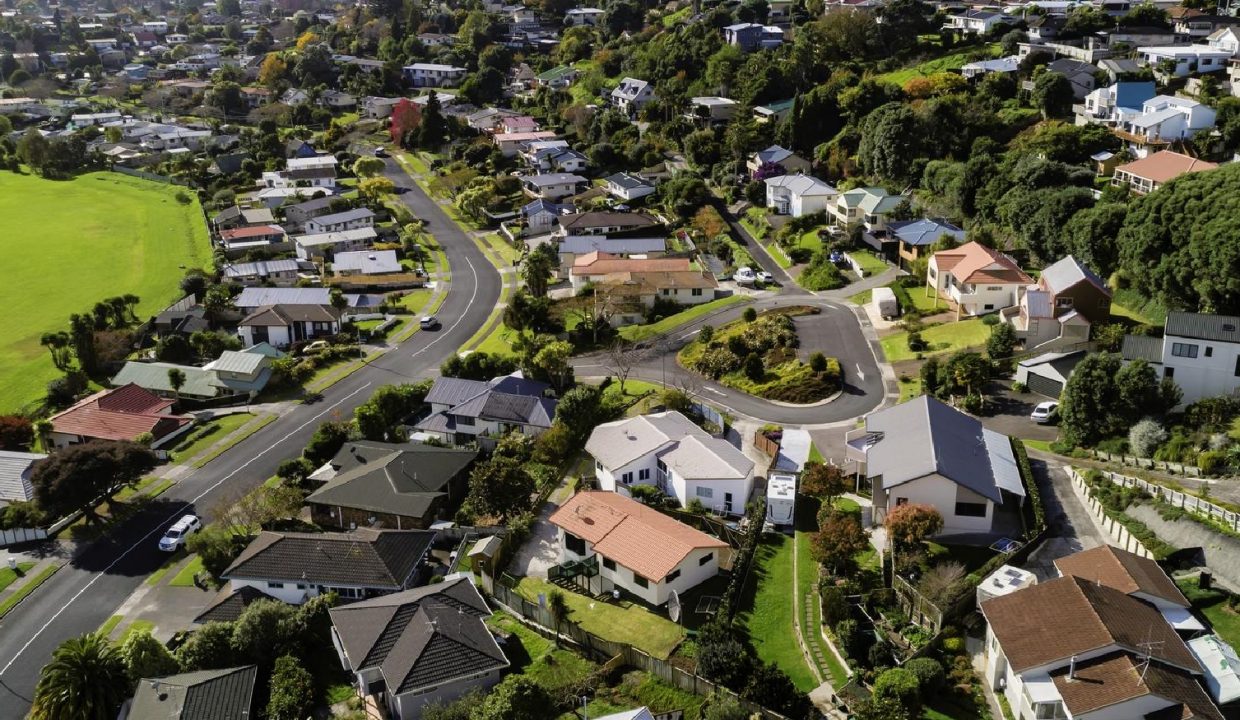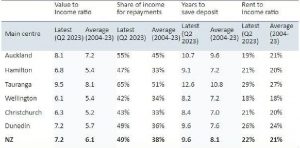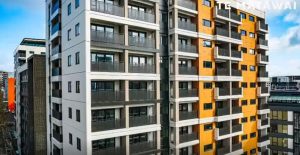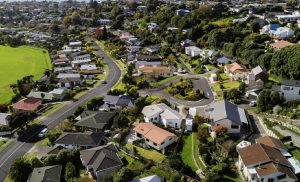
Kiwis spend half their household income on mortgages despite housing affordability improving – CoreLogic

Kiwis are spending half their household income on their mortgage payments, the latest CoreLogic Housing Affordability report shows.
The report, which was released on Tuesday, noted while housing affordability has been improving due to property prices falling, incomes rising and interest rates stabilising, Kiwis are still shelling out huge amounts of cash for their mortgages.
Mortgage repayments as a percentage of gross annual average household income dropped from its peak of 53 percent in the last quarter of 2022 to 49 percent last quarter but is well above the long-term average of 38 percent.
CoreLogic NZ Chief Property Economist Kelvin Davidson said it’s a testing situation for new buyers and relief isn’t expected any time soon.
“Even after the recent improvements, almost half of a household’s income being eaten up by interest repayments is relatively unaffordable compared to long-term averages,” Davidson said.
“Although lower mortgage rates seem likely over a one to two-year horizon, we’re not expecting any relief via rate cuts in the immediate to short-term.
“Given the uneasy prospect that property values may start rising, albeit gradually, once again as we’re already starting to see in a couple of regions, this will only add to the strain on new home buyers, at least until interest rates start to come back down.”
While incomes are rising, Davidson said that will only partially offset the cost of paying a mortgage.
Each of the main centres still has mortgage repayments as a percentage of gross household income at least eight percentage points higher than their own long-term averages, with Tauranga the most stretched and Wellington the least.
Value to income ratio continues to improve
Despite high mortgage costs the value to income ratio of properties in Aotearoa is improving. Properties are now valued at 7.2 times the average household income, down from 7.8 six months ago.
Davidson said the figure has fallen in recent months as house prices dipped and incomes increased due to a strong labour market. But he said the 7.2 rate is still much higher than the long-term average of 6.1.
“The latest figure of 7.2 is significantly lower than Q1 2022’s peak of 8.8 and is the lowest since 7.1 in Q4 2020. In other words, a lot of the strain that emerged post-COVID has been easing but remains elevated by longer-term historical levels,” he said.
Tauranga remains the least affordable main centre, with a value-to-income ratio of 9.5 in the second quarter of this year, followed by Auckland, Dunedin, Hamilton, Christchurch and Wellington.
“After a period of very stretched affordability, the sharp falls in Wellington City house prices lately have seen this part of the country get markedly better in terms of purchasing power and it retains the title of most affordable from Christchurch for the second consecutive report,” Davidson said.
Years to save a deposit reducing
The average number of years it takes for New Zealanders to save for a deposit is also falling, now sitting at 9.6 which is still well above the long-term average of 8.1 but two years better than the worst reading seen at the start of 2022 which was a whopping 11.7 years. The latest figure is the lowest since the end of 2020.
Tauranga has the longest period of time required to save a deposit of any of the main centres, at 12.6 years, well above its long-term average of 10.8 years, and the national figure. But it has started to improve, having peaked at 15.8 years in the first quarter of 2022.
Rental affordability relatively unchanged
While housing affordability is improving, rental affordability is relatively unchanged with increasing incomes generally being offset by rent increases.
Davidson said nationally average households currently spend about 22 percent of their income on rent – slightly above average, but not much different from where it’s been for the past few years.
“The market that stands out is probably Christchurch, which has long been regarded as New Zealand’s most favourable main centre for housing affordability, both in terms of buying and renting, but this no longer applies to the same extent. Indeed, it’s now relatively more expensive to rent in Christchurch than Wellington, Auckland, and Hamilton.”
Affordability outlook
Unfortunately despite the recent improvements, Davidson said because housing affordability started from such a stretched position, it is still significantly worse than normal.
“We suspect this still-stretched starting point for housing affordability will play a role in capping the rate of price growth over the medium term, as would potential limits on debt-to-income ratios for mortgage lending that might be imposed by the Reserve Bank early next year.
“But any growth in house prices, even if modest, will put upwards pressure on many of these measures which will see housing affordability remain a critical issue for NZ in the coming years – even if incomes continue to rise and mortgage rates slowly fall in the longer term,” Davidson said.

주택가격 개선에도 키위들, 모기지 비용에 가계소득의 절반을 투자해 – 코어로직 보고서 발표
최신 코어로직 보고서에 따르면 키위들이 자신들의 가계소득의 절반을 모기지 상환에 투자하고 있다.
이번 보고서는 화요일에 발표되었으며, 주택 가용성이 부동산 가격 하락, 소득 상승 및 이자율 안정화로 인해 개선되고 있다는 사실을 언급했지만, 키위들은 여전히 모기지에 큰 금액의 현금을 지출하고 있다.
지난 2022년 마지막 분기의 53% 최고치에서 지난 분기의 49%로 총 연간 가구소득의 모기지 상환액은 하락했지만 장기 평균 38% 보다 훨씬 높다.
코어로직 뉴질랜드 부동산 경제학자인 켈빈 데이빗슨은 신규 구매자들에게는 시험적인 상황이며, 어떠한 완화도 곧 기대하지 않아야 한다고 말했다.
“최근 개선에도 가계 소득의 절반이 이자 상환에 소모되는 상황은 장기 평균과 비교하여 여전히 비상식적이다” 라고 데이빗슨은 밝혔다.
“낮아질 것으로 보이는 모기지 금리에도, 1~2년간의 전망에도 불구하고 즉각적인 단기 내 금리 인하를 통한 완화는 기대하지 않는다. 우리가 이미 몇 지역에서 보이고 있는 것처럼 부동산 가치가 다시 상승할 가능성 때문에 새로운 주택 구매자들에 대한 압력은 다시 생기며, 적어도 이자율이 내려갈 때까지는 이러한 압력은 계속될 것이다.”
소득이 상승하고 있지만, 데이빗슨은 그것이 모기지 지불의 비용을 부분적으로 상쇄할 것이라고 말했다.
주요 도시마다 모기지 상환액은 총 가구소득의 적어도 8% 포인트 이상으로 자체 장기 평균보다 높으며, 타우랑가가 가장 압박을 받고 웰링턴이 가장 낮았다.
가치 대 소득 비율은 계속 개선되
높은 모기지 비용에도 아오테아로아의 부동산 가치 대 소득 비율은 좋아지고 있다. 현재 부동산은 평균 가구소득의 7.2배로, 6개월 전의 7.8에서 더 낮아졌다.
데이빗슨은 최근 몇 달 동안 주택 가격 하락과 강한 노동 시장으로 인한 소득 증가로 이 숫자가 하락했다고 말했다. 그러나 7.2의 비율이 여전히 장기 평균 6.1보다 훨씬 높다고 그는 말했다.
“최근 7.2의 숫자는 2022년 Q1의 8.8의 최고치보다 훨씬 낮으며, 2020년 Q4의 7.1 이후로 최저치이다. 다시 말해, COVID 이후에 발생한 압력의 많은 부분이 완화되고 있지만 장기 역사적 수준에서는 여전히 상승하고 있다” 라고 그는 밝혔다.
타우랑가는 올해 두 번째 분기에 9.5의 가치 대 소득 비율로 여전히 가장 비용이 많이 드는 주요 중심지로 남아 있으며, 그 뒤를 이어 오클랜드, 더니든, 해밀턴, 크라이스트처치, 웰링턴이 따르고 있다.
디파짓(deposit) 보증금을 모으는 데 걸리는 시간 감소
뉴질랜드인들이 디파짓(deposit) 보증금을 모으는 데 필요한 평균 년수도 점점 줄어들고 있다.
현재 9.6년으로, 장기적인 평균 8.1보다는 여전히 훨씬 높지만, 2022년 초에 기록한 11.7년에 비해 2년 동안 개선되었다. 최신 숫자는 2020년 말 이후로 가장 낮은 수준인 것이다.
타우랑가는 주요 중심지 중 디파짓(deposit) 보증금을 모으는 데 가장 오랜 시간(12.6년)이 필요한 도시였으며, 장기적인 평균 10.8년과 비교해 볼 때 평균 수치를 훨씬 넘어 선다. 그러나 2022년 첫 분기에 15.8년으로 최고치를 기록한 바 있다.
렌탈 임대료에 관한 개선은 변화 없어
주택 비용에 관한 가용성은 개선되고 있지만, 임대료 가용성은 상대적으로 변화가 없다. 증가하는 소득은 일반적으로 임대료 상승으로 상쇄되고 있다.
데이빗슨은 현재 평균 가구가 소득의 약 22%를 렌트비용(임대료)로 지출한다고 말했다. 조금 평균을 넘어섰지만, 지난 몇 년간 크게 달라지지 않고 있다.
“아마도 크라이스트처치가 가장 두드러지는 시장일 것이다. 이유는 오랫동안 뉴질랜드에서 주택 비용에 관한 가용성에 가장 유리한 주요 중심지로 여겨져 왔지만, 이제는 그 정도의 유리함은 더 이상 적용되지 않고 있다. 실제로는 크라이스트처치에서 웰링턴, 오클랜드 및 해밀턴보다 임대료가 비교적 더 비싸지고 있다.”
가격 대비 가능성 전망
유감스럽게도 최근 개선에도 불구하고, 데이빗슨은 주택 구매의 가능성이 이미 이렇게나 긴장된 상태에서 시작되었기 때문에 여전히 평소보다 안좋아졌다고 말했다.
“우리는 이런 여전히 긴장된 주택 구매 가능성의 시작점이 어느 정도의 중기간에 걸쳐 가격 상승률을 제한하는 역할을 할 것으로 예상하고 있다. 뉴질랜드 중앙 은행이 내년 초에 부동산 모기지 대출에 대한 소득 대비 부채 비율에 대한 잠재적인 제한 등의 조치를 취할 수 있기 때문이다.
“하지만 주택 가격이 조금이라도 상승하면, 어떻게든 이러한 지표에 상승 압력이 생길 것이며, 이는 소득이 계속 증가하고 장기적으로 모기지 금리가 서서히 하락하더라도 뉴질랜드의 주택 구입 가능성이 미래 몇 년간 여전히 중요한 문제로 남을 것이다” 라고 데이빗슨은 말했다.

